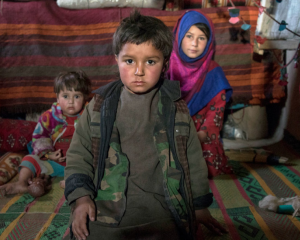Hunger intensifying in Afghanistan
Almost 20 million people – or about half of Afghanistan’s population – are now suffering ‘emergency’ levels of food insecurity, according to the World Food Program (WFP).
More than a million children under 5, who are especially at risk of mortality when deprived of food, are suffering prolonged acute malnutrition, the WFP said. This means that even if they survive, they face significant health problems.
Also, more than 90 percent of Afghans have been suffering from some form of food insecurity since last August, skipping meals or whole days of eating and engaging in extreme coping mechanisms to pay for food, including sending children to work.
Afghanistan’s economic collapse was caused in part by a collapse in most families’ incomes following the Taliban takeover and foreign donors’ decisions to suspend outside budgetary support for numerous government, humanitarian, and development sectors, including education and health.
Meanwhile activist group Human Rights Watch (HRW) says that Afghanistan’s humanitarian crisis cannot be solved unless the US and other western nations ease restrictions to the country’s banking sector imposed after the Taliban’s takeover in August, 2021.
HRW says easing the bans will facilitate legitimate economic activity and humanitarian aid.
“Afghanistan’s intensifying hunger and health crisis is urgent and at its root a banking crisis,” said John Sifton, HRW’s Asia advocacy director.
“Regardless of the Taliban’s status or credibility with outside governments, international economic restrictions are still driving the country’s catastrophe and hurting the Afghan people,” he said.
 Moves by the US and other nations to licence banking transactions with Afghan entities, Afghanistan’s central bank remains unable to access its foreign currency reserves or process or receive most international transactions.
Moves by the US and other nations to licence banking transactions with Afghan entities, Afghanistan’s central bank remains unable to access its foreign currency reserves or process or receive most international transactions.
As a result, the country continues to suffer from a major liquidity crisis and lack of banknotes.
Businesses, humanitarian groups, and private banks continue are reporting significant restrictions on their operations.
At the same time, because outside donors have severely cut funding to support Afghanistan health, education, and other essential sectors, millions of Afghans have lost their incomes.
Acute malnutrition is entrenched across Afghanistan, even though food and basic supplies are available in markets throughout the country, reports say.
Making things worse, Afghanistan’s economic crisis is ramping up as inflation and cost increases have been accelerating, with an over 50 percent increase for basic household items since July 2021.
According to World Bank figures, prices for staples such as rice and wheat have almost doubled in the last two months. At the same time, prices for agricultural inputs such as fertilizer and fuel have doubled, and they are in short supply, meaning Afghanistan’s own domestic food production is set to decrease in 2022.
The crisis’ impact on women and girls is especially severe, reports say.
They say that restrictions on women’s basic rights to freedom of movement and work have made it difficult, even for educated women who used to be financially independent.
Pregnant women are also affected by the situation, especially because of the limited access to health care.
In one sign of hope, Taliban authorities are reportedly prepared to accept independent monitoring of the central bank by outside auditors, a key demand of the US government and World Bank.
But the Taliban continues to reject key demands from governments to remove sanctioned officials from the central bank’s leadership and to reverse their position denying secondary education to girls and women.












